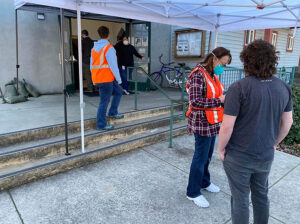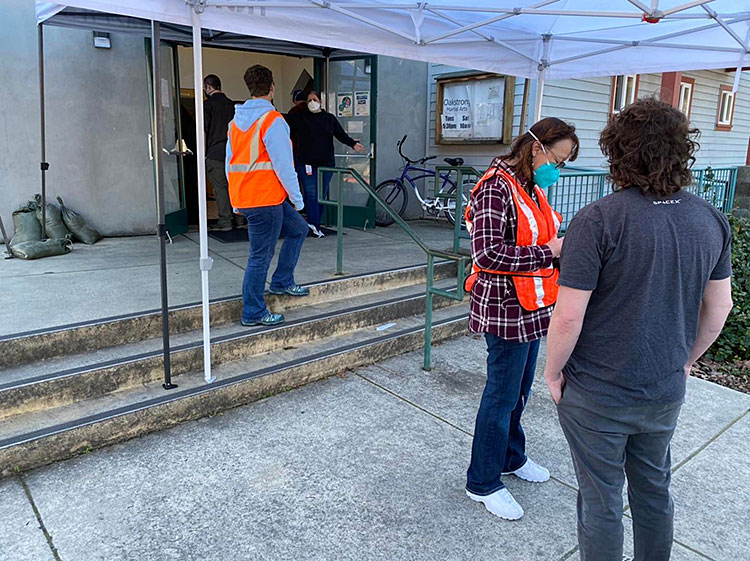By Jondi Gumz
Dr. Richard Pan is a doctor specializing in children and a state senator representing Sacramento since 2014. His bill, SB 277, became law in September 2019 after a measles outbreak at Disneyland — the goal to end the “vaccine exemption loophole” for kids attending public and private schools.

Mee Memorial Hospital is using part of a grant from the federal government to install four billboards along the Highway 101 corridor to encourage the unvaccinated to step up for a shot. Billboards are to be installed from Soledad to San Ardo, communities that have the lowest vaccination rate in Monterey County.
On Jan. 24, with the Covid-19 Omicron variant hospitalizing 15,000 Californians, Pan said he would introduce SB 871 to add COVID-19 to the list of 10 childhood illnesses for which students are required to be vaccinated — and remove the personal belief exemption.
Action may be taken on or after Feb. 24. Track SB 871 at: https://leginfo.legislature.ca.gov/faces/billNavClient.xhtml?bill_id=202120220SB871
On Jan. 31, the state reported 13,000 Covid cases in the hospital. In Santa Cruz County, hospitalizations have fluctuated, as low as 33, currently 44, including 6 in intensive care.
Public health officials consider vaccinations to be the number one tool to prevent hospitalizations and deaths from COVID-19.
A Scotts Valley dad told “The Elephant in the Room” KSCO radio show that his 7-year-old, who is unvaccinated, and he declined to test, was taken out of his classroom on Friday to be taught by a staffer in an unused classroom — same on Monday and Tuesday. He approached the principal, the Scotts Valley schools superintendant, Scotts Valley police chief, county Office of Education, Sheriff’s Office, and District Attorney’s Office, saying he felt his son’s constitutional rights were violated.
Covid cases jumped dramatically last month on the Santa Cruz County Office of Education’s daily dashboard, peaking at 4,400 on Jan. 28, then dropping to 3,166. Test positivity, which peaked in January, is 11.66%.
After Omicron was confirmed in two cases in the county on Dec. 16 and 17, active Covid-19 cases began rising rapidly.
Countywide, 325 cases were confirmed on Dec. 29, reaching 6,6,77 before dropping to 5,638, according to the county health dashboard, which is updated on Mondays and Wednesdays — not daily.
Santa Cruz County has had a “mask indoors” mandate as of Nov. 22.
The assumption is Omicron, the most easily transmissible variant of the Covid-19 coronavirus, is the driving the increase.
Less Deadly?
Omicron may not be as deadly as the Delta variant, which raged in 2021.

Rotary Club of San Lorenzo Valley’s Vax the Valley free clinic at Felton Community Hall on Wednesdays from 1 p.m.-7 p.m.
Omicron left less serious illness in South Africa, but experts are not sure that is true in Israel.
Scotland reported 92 deaths on Jan. 20, 2021, and 4 deaths on Jan. 23, 2022, according to the Johns Hopkins University database.
On Jan. 27, the San Francisco Chronicle reported people are dying at a lower rate than previous surges.
Santa Cruz County reports 239 Covid deaths. As of Dec. 15, before Omicron, there were 225 deaths.
One statistic has not changed: 79 percent of those who died had pre-existing conditions.
Vaccines
California reports 81.9% of residents age 5 and up have had at least one shot.
Santa Cruz County reports 79.15 % of residents have a least one shot and 72.65 % fully vaccinated.
Fully vaccinated means having two shots (Pfizer or Moderna) or one Johnson & Johnson shot. All were developed for the initial Covid-19 coronavirus.
For Omicron, a booster shot is needed. Booster shots are 90 percent effective against preventing Omicron hospitalizations, according to the federal Centers of Disease Control.
Scotts Valley Schools
Scotts Valley Unified School District, with 2,183 enrolled, reported 66 active student cases and six staff cases in January.
Vine Hill Elementary had 22, student cases and three staff cases. Brook Knoll Elementary had 15 student cases and three staff cases.
Scotts Valley Middle School had 19 cases and Scotts Valley High 11 cases. Both reported zero staff cases.
Pajaro Valley schools, with 19,000 students, reported 138 staff cases in January. District administrators filled in for sick teachers.
Aptos High Athletic director Travis Fox suspended indoor sports because testing results did not arrive before game time. Teams have since resumed play.
The CDC says schools in Santa Cruz County are in “substantial exposure,” which prompts a protocol focusing on testing instead of tracing who is spreading virus.
This means unvaccinated students must test twice per week. Those who do not test must quarantine at home and participate in Independent Studies. They are not allowed to participate in athletics and band.
Employer Mandate
On Jan. 13, the U.S. Supreme Court blocked the Biden administration mandate to large employers to vaccinate or test. That means 100 or more employees.
The ruling affects an estimated 84 million workers — and a minority of employers in Santa Cruz County where 82% of businesses have nine or fewer employers. Many of the large employers are medical facilities, schools or colleges.
The ruling said the federal Occupational Safety and Health Administration, which regulates occupational hazards, did not have the right to regulate public health broadly.
The court allowed a federal vaccine mandate applying to medical facilities that take Medicare or Medicaid payments. That affects an estimated 100,000 workers.
OSHA said it is withdrawing the vaccine and testing requirements for large employers. Employers can mandate vaccines or tests for their employees if they feel it’s needed.
Protesting Mandates
On Jan. 23, Children’s Health Defense, headed by Robert F. Kennedy Jr. https://vaers.hhs, rallied 20,000 to 30,000 people to a peaceful protest in Washington, D.C., at the Lincoln Memorial, calling for an end to vaccine mandates, a strategy used by President Biden and California Gov. Gavin Newsom.
Kennedy, an attorney and a passionate advocate for vaccine choice, mentioned Anne Frank, who was Jewish, hiding to escape Nazis, a reference for which he apologized a day later.
In Brussels, 50,000 people filled the streets, protesting vaccine passports and Covid restrictions. Masked demonstrators broke a glass entrance to the office of the EU’s foreign policy agency, an action recorded on Twitter, and police fired water cannons and tear gas to break up the protest.
Public health officials say the scientific consensus is that Covid vaccines are safe, but protest leaders were skeptical about relying on science from drug-makers, which saw profits rise in 2021. They point to the U.S. government database, https://vaers.hhs.gov where health care providers are to report adverse events after a vaccine.
The reporting site was created after Congress passed a law in 1986 protecting vaccine manufacturers from civil personal injury lawsuits and wrongful death lawsuits resulting from vaccine injuries.
After Covid arrived, Health and Human Services Secretary Alex Azar invoked the Public Readiness and Emergency Preparedness Act, a 2005 law that allows the HHS secretary to provide legal protection to companies making or distributing critical medical supplies such as vaccines unless there’s “willful misconduct” by the company, according to a report by CNBC.
This lowers the cost of immunizations, and the protection lasts until 2024. HHS declined requests by CNBC for an interview.
Dr. Pamela Popper of Ohio has sued HHS, FDA and CDC concerning use of vaccines for kids under 16, hopes to get discovery, the point at which both sides can get evidence. Updates are at https://makeamericansfreeagain.com/
On Jan. 6, federal judge Allen Winsor ruled in Florida to deny a motion by the U.S. Department of Defense seeking to block discovery of evidence. The lawsuit was filed by 18 service members challenging the vaccine mandate.
Hospitalization
The question is: Will hospitalizations in Santa Cruz County rise — or decline, as in San Francisco.
Possibly people entered the hospital with another condition or for scheduled surgery, then got tested for Covid. The state dashboard does not explain.
Local cases are split between Dominican Hospital in Santa Cruz and Watsonville Community Hospital, which filed for Chapter 11 bankruptcy protection while trying to orchestrate a sale to a Pajaro Valley consortium. Bids are due Feb. 14.
Earlier, county health officials urged people with no symptoms or mild symptoms to stay home rather than going to the hospital emergency department.
Under the 1986 federal law EMTALA, emergency departments must treat everyone who comes in, regardless of ability to pay — an unfunded mandate.
Responding to a Times query via email, the California Department of Public Health estimates Omicron comprises 91% of cases statewide and Delta 6.5% but the state does not have a breakdown of Omicron hospitalizations or deaths.
Not all COVID-19 cases requiring hospitalization are sequenced, the state emailed in response to the query, and the proportion of cases due to the Omicron variant that die is still being determined.
Santa Cruz County reports 239 Covid deaths, up from 225 as of Dec. 15.
One statistic is similar then and now: 79 percent of those who died had pre-existing conditions.
Who do people fear Omicron?
It could be they have a pre-existing condition (diabetes, obesity, asthma, high blood pressure).
Half of Americans do, so they are at higher risk for severe Covid illness. So are people 85 and older.
Some people who got Covid experience “long Covid,” with symptoms such as fatigue and brain fog months afterward.
A 2022 study in the journal Cell by researchers who followed more than 200 patients found biological factors that might help predict “long Covid.” At diagnosis, many acute patients had low cortisol, which could be addressed.
Testing
When active cases skyrocketed in Santa Cruz County, there was greater exposure, great demand for testing, and delayed results.
Santa Cruz County Office of Education, which partnered with Inspire Diagnostics to provide 245,600 tests, posted that results may now take 48 to 96 hours. An optimal turnaround is 24 hours.
The County Office of Education offers drive-though testing for students, staff and families at these locations:
Cabrillo College, Aptos, Parking Lot K, Monday to Friday 9 a.m. to 5 p.m. and Saturday 9 a.m. to 3 p.m.
Santa Cruz County Fairgrounds, 2601 E. Lake Ave., Watsonville, Monday to Friday 10 a.m. to 5 p.m., and Saturday 9 a.m. to 3 p.m.
Santa Cruz County Office of Education, 399 Encinal St., Santa Cruz, Monday to Friday, 2 to 5 p.m.
On Feb. 2, the California Department of Public Health reported a 13.4% test positivity rate statewide, down from 23% and 18.8% earlier in the month.
For information about testing, isolation guidance and masking, see the Jan. 7 letter from school superintendents on the county Office of Education website.
The new CDPH Guidelines notes the importance of wearing a face covering which has multiple layers.
Hundreds of school staff have rapid response antigen tests, courtesy of the Santa Cruz County Office of Education, and schools are distributing more for at-home use. Directions are posted at drive.google.com/file/d/1U8AdsSyH14sDvrjD6T25krhvOFRFsuXs/view
Journalism coach Roy Peter Clark, at Poynter.org, cautions the directions are not as clear as you might want.
For test options see: https://tinyurl.com/get-tested-santa-cruz.
Shorter Isolation
Based on federal recommendations, the state has updated isolation guidance for those testing positive, shortening the requirement from 10 days to five days.
Dr. Cal Gordon, Santa Cruz County deputy health officer, recommends booster shots for children ages 12-15 for Omicron, as the state allowed on Jan. 6. A third dose is available for eligible immunocompromised children ages 5-11.
SLV Rotary is partnering with Felton Community Hall, Highway 9, to offer weekly vaccine clinics 1 to 7 p.m. Wednesdays — no charge. Need a ride? Call 831-291-8644.
Booster shot appointments can be scheduled at https://myturn.ca.gov/ and by checking with your local doctor and pharmacies. For local COVID-19 vaccine providers, visit www.santacruzhealth.org/coronavirusvaccine.
For help scheduling an appointment, call the Community Bridges Helpline at 831-219-8607 or 831-440-3556 (English, Spanish, Mixteco and Triqui).
For local information on COVID-19, go to www.santacrushealth.org/coronavirus or call (831) 454-4242 between 8 a.m. and 5 p.m. Monday through Friday.
•••
Total COVID cases: 5,638
•••
COVID Deaths: 239
As of Jan. 31
Age
85 and older: 102 • 75-84: 53 • 65-74: 43 • 60-64: 15 • 55-59: 3 • 45-54: 10 • 35-44: 8 • 25-34: 5
Underlying Conditions
Yes: 190 • No: 49
Race
White 134 • Latinx 85 • Asian 16 • Black 1 • Amer Indian 1 • Other 1 • Unknown 1
Gender
Men: 122 • Women: 117
Location
At facility for aged: 112 • Not at a facility: 127

